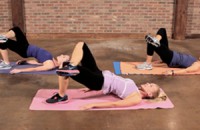The Boob Group
Breastfeeding Twins: 6-12 Months Old
Please be advised, this transcription was performed from a company independent of New Mommy Media, LLC. As such, translation was required which may alter the accuracy of the transcription.
[00:00:00]
[Theme Music]
Robin Kaplan : Breastfeeding twins changes drastically over time. As twins babies get older, and are no longer newborns, positioning, timing and breastfeeding in general can become easier. What are some common breastfeeding positions for twins age 6 to 12 months? And what are some tips for handling distractibility and nursing in public? Today, we welcome back our twins breastfeeding expert, JonaRose Feinberg, an International Board Certified Lactation Consultant, in private practice in the Seattle area, the owner of Twins and Mind Consulting and the editor of BreastfeedingTwins.org.
[Theme Music/Intro]
Robin Kaplan : Welcome to The Boob Group, broadcasting from the Birth Education Center of San Diego. The Boob Group is your weekly online, on the go support group for all things related to breastfeeding. I'm your host, Robin Kaplan, I'm also an International Board Certified Lactation Consultant, and owner of the San Diego Breastfeeding Center. Thanks to all of our loyal listeners who have joined The Boob Group Club. Our members get all of our archived episodes, bonus content after each new show, plus special giveaways and discounts. Subscribe to our monthly newsletter for a chance to win a membership to our club each month. Another way for you to stay connected is by downloading our free app, available in the Android and iTunes marketplaces. In our studio today we have two lovely panelists. Ladies, will you please introduce yourselves?
Amy Salazar : Hi! My name is Amy Salazar, I am 33, and I am a stay at home mom of three boys. My oldest son is 4, and I have twins that are 11 months.
Devon Wieber : Hi! My name is Devon, I am 25, I'm a housewife. I have a 2 year-old son, and eight-month-old twin girls.
Robin Kaplan : You guys have some serious busy houses. Well, welcome to the show, ladies, it's so nice to have you.
Amy Salazar : Thank you!
Devon Wieber : Thank you!
[Theme Music] [Featured Segment: News Headlines]
[00:02:25]
Robin Kaplan : Before we get started with our episode today, we are going to talk about what's going on in the news in headlines over the past couple of weeks. One of my most favorite viral videos going on right now is Hollie McNish, defending breastfeeding in public. If you haven't heard of this fantastic spoken word viral video going on, Hollie McNish is a British poet and mother, and has taken the breastfeeding world by storm with her defense of breastfeeding in public. It's actually titled “Embarrassed”, and she talks about how for the first six months of her baby's life, she nursed her daughter in public restrooms, after being told she should just stay home the first time she tried to breastfeed in public. If you haven't heard it yet, we'll be linking to it on this page, of our episode on our website. But the way she closes her poem I think really kind of ties up the entire three minute segment she has, and essentially is in this country of billboards covered in tits. I think we should try to just get used to this. And so, ladies, what did you think when you first saw this video? Amy?
Amy Salazar : It gave me chills, I shared it to my husband's page and said, “Yes!” I loved it. It was everything I've been thinking and you want to express. She did a wonderful job.
Robin Kaplan : Absolutely powerful, right?
Amy Salazar : It was.
Robin Kaplan : How about you, Devon?
Devon Wieber : I just saw it and I completely agree with her. I know a lot of people that don't feel comfortable nursing in public, and for my friends that just had babies, I always try to encourage them.
Robin Kaplan : It's nice to have a support system when you're going to try to nurse them in public too, 'cause one negative comment and it can just send you spiraling. I was watching this, I had found it on Facebook, and it was like 11:30 at night, right before my husband came into bed, and he comes into bed and, “I just have to turn this on really quickly, 'cause everyone keeps telling me I need to watch this”. And I just start crying, and he was like, “Holy shit! She nailed it!” The way that she talks, she uses very strong words, I think she really got her point across, but absolutely true, how can you not normalize this, when all the billboards that you see around you have all of it showing anyways. We're super excited to link this to our website, that way it can be left there into eternity, and everyone can take a look at it. Thanks ladies!
[Theme Music]
[00:05:01]
Robin Kaplan : OK, so today on The Boob Group, we're discussing breastfeeding twins, aged 6 months to a year. Our expert, JonaRose Feinberg, an International Board Certified Lactation Consultant, in private practice in the Seattle area, the owner of Twins and Mind Consulting and the editor of BreastfeedingTwins.org. Thanks for joining us, Jona, and welcome back to the show.
JonaRose Feinberg : Thanks for having me. Always fun.
Robin Kaplan : Absolutely. Jona, how is breastfeeding twins between the ages 6 months to a year different than breastfeeding during those first few months, which we've talked about in a previous episode?
JonaRose Feinberg : I think in general it's easier, there are some things about toddlers, I think it's some kind of juggling, but I think that initial newborn fog has lifted, most of the early respiratory issues that you might have had have been solved, you are generally past latching problems, and just having sleepy babies or accommodating premies, you're kind of in a place where moms start to feel self confident, the babies are stronger, they have head control, which gives you a lot of options in positioning, and also just to make moms feel like, “OK, I got this, we're going to do this, we're great”.
Robin Kaplan : And speaking of positioning, how do breastfeeding positions change now, that the babies have better head control, are starting to sit up? Are there some common breastfeeding positions for twins at this age?
JonaRose Feinberg : Yeah. When babies are smaller, moms tend to feed in some combination of cradle, and as they get head control, moms can experiment with all sorts of positions. Some moms like to feed their babies standing up, you keep a baby on each of mom's legs, mom can feed both time in a comfortable chair. I think a lot of moms use their twin nursing pillows, through much of the first year, especially at home. They often have to kind of find a way to adjust the pillow to support them. So finding a new place to sit where they can have some back support, or there is room for the baby's legs, as the babies get longer, sometimes people curl around their back, so it's kind of a hugging nursing position, which is kind of friendly. Sometimes the babies pop their legs up on the back of the couch, sometimes they start doing that, but we call those gym nurse, they are in all sorts of funky positions, where they just kind of crawl over and go at it. You get a lot more flexible with their positioning.
Robin Kaplan : That's awesome. So ladies, how is breastfeeding your twins changed over the past few months? Amy?
Amy Salazar : Pretty much everything she just said, I was just thinking while she was talking that mom doesn't have a lot of control sometimes, when it comes to how they position, they just go where they want to go, so one might be cradling and then they turn around to the other side, and they just move a lot. So this mom doesn't have a lot of control sometimes. But it's kind of fun.
Robin Kaplan : They are figuring it out, they know where to go. How about you, Devon?
Devon Wieber : At first I had a nursing pillow, and that wasn't very comfortable. They were doing the football hold, but now I hold both their legs.
Robin Kaplan : Yeah, heads at breast and then their feet kind of crossing in a V in front of you.
Devon Wieber : They seem really comfortable with that.
Robin Kaplan : Do they hold each other's hand?
Devon Wieber : Yes. It's the sweetest thing I've ever seen in my entire life.
Amy Salazar : My mom always looks at it and she's like, “They're like little animals, they don't care how they are, what's their position, they're just happy!”
Robin Kaplan : That's a really good point, 'cause if you've ever seen – like if you were a kid and seen farm animals – they're crawling over each other, they're going from boob to boob, just moving around and everything. I guess for an animal, they have teeth... but at the same time, just really kind of moving around and just figuring out how to get there. So do you find, Jona, do you find that when babies are nursing at the same time around, we're talking about holding hands, moving around, distractibility. With single kids as well, you know that at this age they are super distractible too. Something goes past them in the room and they are like, “Uuu! Shiny!” Sometimes with the breast in the mouth and they're turning around to see. Do you find, Jona, that it's more intense when two babies are distracted by every fleeting movement and sound, and do they tend to distract each other?
JonaRose Feinberg : Sometimes they do. There is absolutely turning, hand holding, and sleeping with each other, which I think kind of makes up for he time they poke at each other or there is a lot of hair pulling going on, they are kind of passing over who is going to be. They certainly can get at it with each other. But I think also sometimes, especially in this age, sometimes this is the time when they settle. Like they've been all over the place, and somebody has sat, and somebody takes a toy from somebody else, they sit down and try to settle it, everybody comes over to nurse, and everything settles down a little bit. Doesn't always happens, but sometimes it can be a really powerful tool that way. So sometimes they get distracted, and sometimes they get settled.
Robin Kaplan : Do you find that when they are distractible, does this tend to affect their breastfeeding routine and schedule for moms? What tips do you have for keeping these little ones focused while they're feeding?
JonaRose Feinberg : I think it's the nursing together, especially if you are in a more traditional hold, this tends to be on the younger end of this range, but sometimes you need to put a physical barrier between the babies, like an extra pillow or even – I've known moms who were using the nursing pillows literally vertical between the babies, “This is your side, this is your side, everybody stay separate”. I've certainly seen that. Sometimes there is all that normal distractibility age, where you need to go to a quiet room, where it's dark. Sometimes you need to nurse them one at a time, so they can settle down and focus. Sometimes you think you're going to nurse just one baby, and the other baby is like, “Hey! I want a piece of that!” And they crawl right over.
Robin Kaplan : Perfect. So, ladies, do your babies tend to distract each other while they're breastfeeding? And if they do, how do you handle this? Devon, what do your kids do?
Devon Wieber : Sometimes they do distract each other, they will either grab each other's face, or one will pull off and hit the other one. If they do that, then I can tell they are not interested in nursing anymore, so I'll just put them on the floor and play with them. Or let one stay and put the other one on the floor, whatever needs to happen.
Robin Kaplan : Yeah, making sure that you are assessing each child's needs. Perfect. How about you, Amy?
Amy Salazar : Pretty much the same thing. I'll get on the floor at that point usually and one can go crawl up, and if one wants to stay, he will just stand there and be latched on and then go off, and then come back.
Robin Kaplan : That's a really good point, do you find that you nurse on the floor, are you more on the couch? Where are you nursing, all over the place?
Amy Salazar : All over the place.
Robin Kaplan : 'Cause I would imagine sitting on the floor would actually be really easy.
Amy Salazar : I do it in my recliner, just 'cause I have both arms propped up already. I can just relax and let my toddler play and do what I need to do.
Robin Kaplan : Jona, last episode we talked about setting up a physical space to breastfeed, and this was obviously for the younger kids. Do you think that this is necessary by about 6 months, as we even get into a year? Are you finding that a space is actually helpful, or we're kind of just going off of where these kids want to go and you're kind of their pit stop?
JonaRose Feinberg : I think more often it becomes a free for all, you kind of go with the flow. I think it's still really important to have your supplies handy, maybe it's a little basket you grab, because there is nothing worth in getting everybody settled and then not being able to reach your water or whatever you need. So I don't think you need a full nursing station set up so much as you do when they are really little, but having your stuff handy can really help.
Robin Kaplan : That's a great tip. Alright, well when we come back, we will discuss with Jona logistical tips for handling twins, as well as advice for nursing in public. We'll be right back.
[Theme Music]
[00:13:11]
Robin Kaplan : Alright, welcome back to the show, we're here with JonaRose Feinberg, an International Board Certified Lactation Consultant in private practice in Seattle, and we are discussing twins, age 6 to 12 months. Jona, what are some tips for just basic management of two babies between the age of 6 months and 12 months? For example, getting babies into the car when you need to go out, or managing two crawling babies who happen to be crawling in different directions? What are your favorite tips for these types of things?
JonaRose Feinberg : I think at this age the most important thing is probably really really good proofing, because you can't possibly everywhere with both babies at the same time. I'm not talking about little latches, it might have been OK with one baby that you can kind of latch, but have a whole space room. Some moms have a playground with toys when they are younger, but by the time they get older and really mobile, a lot of times people have a whole room that's completely for this, or a large area. So there's nothing they can get into, and you can put the babies in there and know that they are contained. Something big enough that you can get in with them. It's also really useful while you are getting yourself ready to go to the car, or to go anyplace else, just to know that you have a safe zone. In terms of getting back and forth to the car, different people find different things that work. I think people use those car seats to carry babies as long as they can, even though they are really heavy, because they are contained and you can carry them around. When they get to big for that, which definitely happens. I put one baby in a sling, on one hip, and then carry the other one in the other arm, which works with two, when you add another kid into the mix, it's all about the zone defense.
Robin Kaplan : I like that idea about the sling, that's a great idea. Ladies, what have been some kind of life saving management skills you have learned recently with your kids? How do you keep them from hurting themselves and getting where you need to go and stuff? Devon, what do you think?
Devon Wieber : I had a baby a year ago, and that helps so much. And I have two double strollers, so with my toddler I can just put him in one, and then the other one in the other side, and wear one. That really helps. And just don't get stressed. That's the number one thing.
Robin Kaplan : And building some extra time.
Devon Wieber : Yeah, for sure.
Robin Kaplan : How about you, Amy?
Amy Salazar : That's a big one. Baby wearing has saved my life. I baby wore with my first son, but really I have my tula, I had my ovens when they were little, but now the tula is so much easier. So just always wearing at least one. It's nice having my older son be able to – he can push the stroller sometimes too, if for some reason I need that little extra help. But baby wearing I would say is the hugest thing.
Robin Kaplan : Jona, what do you remember being the most challenging task with twins, and what helped make it easier and more manageable?
JonaRose Feinberg : There isn't just one thing that stands out from the others. I think every stage brings its own challenging moments, and then, just when you got it all set with whatever that thing was, there is a new thing. The most helpful thing for me was reminding myself that everything is a stage and that we would get through it, and also, not getting too full of myself when we did, because I knew that there will be another stage, something else to work out. Whatever it is, we're all struggling with our challenges and then we get through it. And we figure out how to get our crawling babies out of the car, and then they start walking, and we figure out how to get our walking babies out of the car, and then the car seat situation changes. It's always something, and you just have to kind of go with the flow and you'll get through it.
Robin Kaplan : How about you, Amy, what do you think has been the most challenging in the past couple of months? What's helped to make it easier?
Amy Salazar : I know, the most challenging is when they fall asleep in their car, and then you have to go somewhere, and now you have to get – I have three kids – and now you have to get three kids unbuckled, wake them up, all of that. I think that's the most challenging thing. You have to do something for your older kid, and then your younger kids are sleeping or whatever.
Robin Kaplan : Are they still in infant carriers?
Amy Salazar : I never had an infant carrier, I always just wore them. But I think that's the biggest challenge, even if you just have twins, two kids on maybe different sleep schedules, one's awake and one is asleep.
Robin Kaplan : That's a really good point. Devon, how about you?
Devon Wieber : Definitely, juggling all three kids. It's a big deal.
Robin Kaplan : What's helped the most for you?
Devon Wieber : Getting them on the same schedule.
Robin Kaplan : Was it easy to get your twins on the same schedule, would you say?
Devon Wieber : No.
Robin Kaplan : But you seem to have done that now, is it better?
Devon Wieber : Yes.
Robin Kaplan : And your kids are 8 months-old now?
Devon Wieber : Yeah.
Robin Kaplan : OK, so that's a really good point, that even though it's challenging in the beginning, it does get easier and easier, and there is a good chance you are going to be able to put them on a similar schedule.
Devon Wieber : I never tried to put them on a schedule, but they kind of fall into it too. Even though one might wake up a little bit earlier, but they kind of fell into it. That was nice. Another thing is letting your friends, if you have plans, know that, “I'm going to be there at 12ish, maybe close to 1”.
Robin Kaplan : That's a good point. Anyone with more than one child, whether they are the same age or not, it's helpful to build in that buffer zone. Jona, what about managing feeding time. Especially if the baby are not tandem nursing? Do you have any tips for that, say one's bottle feeding and one's breastfeeding?
JonaRose Feinberg : I think that having a safe place for the other kids to be into, that you can relax a little bit, is really really helpful. If you've built that safe zone, that's big enough for you to go into, then you can sit on the floor and you can still interact with the non-nursing baby. Again though, sometimes that prompts the non-nursing baby to want to come right over and join the party, what we jokingly call “gealous breastfeeding”. They aren't actually particularly interested, but as soon as they see that it's happening, they are like, “Wait a minute, I think I want some of that. I just ate, I'm not actually hungry, I want to be part of where mommy is”.
Robin Kaplan : Everyone is laughing in the studio, by the way, they are like, “A-ha!” Jona, the biggest question I get from moms of twins is how to breastfeed twins in public. I would imagine putting two babies under a blanket would be a little chaotic. Sometimes just putting one over a blanket. And I know you've described nursing in public initially as creating like a circus. What are your top five tips for nursing in public with multiples?
JonaRose Feinberg : I'll see if I can come up with five. I would experiment with positions, maybe a more upright position, like having the babies sit upright on each leg. Because you're not needing pillows, you're not showing so much skin. Wearing clothes that are conducive to nursing in public, whether that's a special nursing shirt or those nursing tops where you just flip down the little flaps but the rest of you is still covered, you're not doing a whole production with your clothes, it simplifies things. Sometimes, even babies that like to nurse together, sometimes out in public it's easier to nurse them one at a time, maybe the other can sit in the stroller. When they're young enough to be contempt sitting in the stroller, you can often walk the stroller with your foot, while the baby is weaning. It works better if you took a nursing session, touched them before they are really hungry. But again, they might want in again on the action, so it's worth to try. Otherwise, I think finding a quiet place to nurse, so the babies can focus. And they get more efficient as they get older, so it tends not to be quite as much of a production as nursing little babies in public. I know a lot of moms that feed the babies in the back of their car, before they go in to someplace where they think it's going to be awkward. I don't want to say that you should always feed in your car, because it's not really so comfortable most of the times, but sometimes you do what you need to do to make the outing as comfortable and mellow for everybody as possible.
Robin Kaplan : Alright, you got five tips, nice! And how does the introduction of solid foods impact nursing in public? Do you think that this makes it easier, if one can snack while the other one's nursing?
JonaRose Feinberg : I think it definitely does, I think when your baby is eating solids, it can either be an option for satisfying hungry babies while you're out, because they can have a snack and then they can hold out a little bit longer, or it gives them something to do while they wait, especially when they're really interested in picking up Cheerios and things like that, which takes a lot of focus, that can buy you some time and activity. Obviously, make sure they continue breastfeeding, you don't want them to skip a nursing session in favor of giving your kids some Cheerios, at this age, but having a snack can definitely buy you some time and flexibility, which can be really helpful.
Robin Kaplan : Awesome. Ladies, how do you nurse your kids in public, what's worked best for you and your babies? Amy, how about you?
Amy Salazar : We've done it every which way you can. We kind of just do it how it works best in that situation. I've used no cover, I've used the cover, the tank top thing works for me, just wear the tank top, pull it up, so you're not showing as much skin. If I can tell that they are going to be really looking around and I'm going to flash everybody, I'll usually feed one before. So once in the car seat, and I feed the other one, where they can still see me, but not the other one, so they don't get gealous, and then I switch so that he's in the car seat, and then we go wherever we have to go. Or when we're leaving, I just do that, I put one in and kind of do that. But we've done it every which way you can do it.
Robin Kaplan : We'll get to you, Devon, too, but do you have a tip for a mom who was kind of anxious about nursing her twins in public? What might be the easiest way to kind of ease into it I guess?
Amy Salazar : Oh gush, I don't know.
Robin Kaplan : Would you say you just kind of jumped into it, was it like, “Alright, we're going for it!”, or did you take some steps to where you felt more comfortable?
Amy Salazar : I guess I realize I just got to do this. 'Cause they're going to need to eat. I did start – when I tandem, using a cover, and then I realized that they didn't like it. And then just the tank top I think is the best, 'cause you can show very limited amount of skin if you wear the tank top under.
Robin Kaplan : Absolutely. How about you, Devon?
Devon Wieber : The first couple of months we didn't really leave the house much, they were very high needs babies, so we didn't really need to nurse in public. Now they're eating solids. So I can nurse one, give the other one solids, and then switch off if I need to. But I have a cover also.
Robin Kaplan : Have you found that when solids were introduced you were able to kind of manage the whole feeding situation?
Devon Wieber : Yes, definitely.
Robin Kaplan : How does that work for you, Amy?
Devon Wieber : They're not really into solids, they would much rather have the boobs, that's why I kind of have to hide – not hide, they can still see my face, but not see the other one. That kind of works. Or just that I have to tandem them.
Robin Kaplan : I know, and once you get used to it, too, you figure, “Alright, let's go!”
Devon Wieber : Yeah, we're just doing this.
Robin Kaplan : Jona, do you have anything else you want to add?
JonaRose Feinberg : I think that we don't see nursing in public enough, at all, and especially not among moms with more than one baby. So you would rather be the role model, because the more you see it, the more people will become comfortable with it, and they'll think that, “OK, she's nursing her baby and she's managing them”. And then, when you do that, you're being a mom and that's the thing to do.
Robin Kaplan : Absolutely. And Amy, the way you mentioned it, too, like sometimes – or was it Amy or Jona? Sometimes take the kids down a notch too. If you feel like you've got some crazy babies going on, you put them on and I would imagine most people would be much happier to see content babies nursing rather than two screaming kids not getting their needs met. Well, thank you so much Jona, for sharing this incredible valuable information about breastfeeding twins, age 6 to 12 months. And to our panelists as well. And for our Boob Group Club members, our conversation will continue after the end of this show, as Jona will discuss how breastfeeding continues to become even more manageable and enjoyable after these first 12 months. So something for you all to look forward to. For more information about our Boob Group Club, please visit our website at TheBoobGroup.com.
[Theme Music] [Featured Segments: Lose the Baby Weight]
[00:26:33]
Autumn : Hi Boob Group! Autumn here, from MyTailoredFitness.com, the fitness program that allows you to build your own custom workout video, and get a great workout in the comfort of your home. Here are some ways you can exercise with your baby. Walking with your baby in the stroller is a great way for new moms to exercise. Being outside will lift your spirits and the fresh air is good for your babies too. When you push your stroller, be sure to keep your shoulders back and down, and your arms relaxed. Your wrists should be neutral, or in line with your arms. When you walk up a hill, keep the stroller close to your hips, and your abs pulled in tight. Your stride should be long and your foot should strike heel to toe with each step. Once you have your doctor's clearance to begin exercise, start by walking around your neighborhood. And try adding five to ten minutes to your walk each week. This is the perfect way to ease back into exercise and begin rebuilding your strength. There are also lots of great strength exercises that you can do with your baby. Sign up for a free 30-day membership at MyTailoredFitness.com, and try out our exercise with your baby video series. For more great info about carrying for your little one, keep listening to The Boob Group.
[Theme Music]
Robin Kaplan: This wraps up our show for today, we appreciate you listening to The Boob Group. Don't forget to check out our sister shows, Preggie Pals, for expecting parents, and our other show, Parent Savers, for moms and dads with newborns, infants and toddlers. Coming up next week, we have – I don't know who we have next week. Just kidding! Thanks for listening to The Boob Group, your judgment-free breastfeeding resources.
[Disclaimer]
This has been a New Mommy Media production. Information and material contained in this episode are presented for educational purposes only. Statements and opinions expressed in this episode are not necessarily those of New Mommy Media and should not be considered facts. Though information in which areas are related to be accurate, it is not intended to replace or substitute for professional, Medical or advisor care and should not be used for diagnosing or treating health care problem or disease or prescribing any medications. If you have questions or concerns regarding your physical or mental health or the health of your baby, please seek assistance from a qualified health care provider.
[00:28:54]
[End Of Audio]












